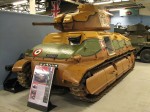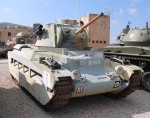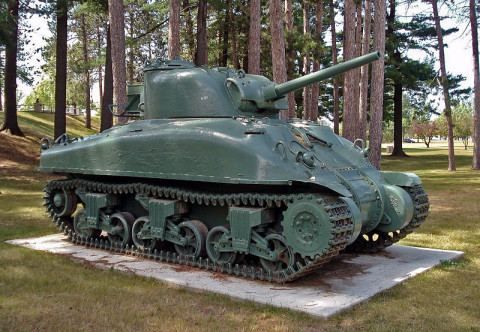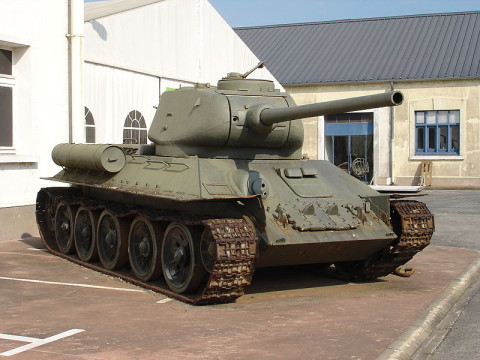Nigel Davies revisits one of the perpetual debates among amateur WW2 historians:
Let us start with the issue of tanks from the perspective of propaganda. More rubbish has been written about who had the best tanks during the Second World War than about any other topic to do with that war. Again and again you get supposedly serious historians talking about how the Germans started the Second World War with overwhelming tank superiority; that the Allies were only brought back into the race by the arrival of the Sherman tank; and how German technology leapt ahead again at the end of the Second World War to give them unrivalled vehicles. All these statements are of course completely incorrect.
One of the problems of course, is ‘best tank when, and for what?’
Comparing what was available in 1939/40 to what was being produced in 1945 (say a Panzer III or Matilda II with a Centurion or Stalin), is worse than useless. There is no comparison. Only the Panzer IV was actually produced throughout the war: and the heavily armoured final version of the tank — with a long barrelled 75mm gun capable of taking on almost every tank yet operational in mid 1945 — bore only a passing resemblance to the lightly armoured tank with a short barrelled infantry support gun — of with minimal ability to do more than scratch the paint of a CharB in 1939/40.

SOMUA 35 tank at Bovington Tank Museum (via Wikipedia)
It’s relatively easy to do a quick measurables test comparing one tank against another: thickness and location of the armour, size and muzzle velocity of the main gun, engine horsepower, road speed, etc., but the very best tank on all of those measurements could still be beaten by an enemy using better combat tactics: the French
SOMUA 35 and the British
Matilda II were the best tanks in the world in 1939 and 1940 respectively (according to Davies). In spite of the superior measurables, the SOMUA 35 was incredibly limited by having the tank commander also be the gunner and loader and it lacked a radio for communication (and even if they had been so equipped, the already overworked tank commander would have had to be the radio operator, too). The Matilda was designed as an infantry tank, so it was very heavily armoured, but relatively slow and somewhat undergunned (the 40mm main gun only had solid shot for anti-armour use: there was no high explosive round for softer targets).

Matilda II at Yad la-Shiryon Museum (via Wikipedia)
It also helped that too many British cavalry officers in the desert war still had a “tally ho!” attitude and were frequently drawn into unsupported tank charges against German or Italian tanks who were able to draw the fast but lightly armoured British cruisers into easy killing range of their anti-tank guns.

M4A1 Sherman tank at Canadian Forces Base Borden (via Wikipedia)
For several months, it seemed as though the mechanically reliable Sherman would be a war winner, despite its notable tendency to explode in flames whenever it was hit. (Allied troops refer to it as a Ronson — “lights first time every time”. German troops just referred to it as a “Tommy Cooker”.) But this concept was fantasy, which could be easily demonstrated within a few months, though it took the US government another two years to admit it.
[…]

T-34/85 at musée des blindés de Saumur (via Wikipedia)
The Tiger is a problem for this sort of discussion, because it re-introduces the concept of ‘what for’ into the debate. The Tiger was a far superior heavy infantry support or assault tank to the T34, but a far inferior battlefield manoeuvre or pursuit tank. In fact the Tiger was so slow and limited in cross country ability, that it was actually more effective as a defensive weapon once the Germans were thrown back on that approach, than it had been for re-igniting their Blitzkreig glory days.
He sums up the post with a league table of “best tanks” for given years and purposes:
Having noted the necessary division between medium cruisers and heavy assault/infantry support tanks however, we can still make a fair summary.
So, in contrast to what many history books and documentaries will tell you, the French had the best tanks in 1939, and the British had the best tanks of 1940 and 1945. Also in contrast to what many history books will tell you, the Shermans effective front-line role can best be defined as the few months between the battle of Alamein, and the arrival of Tiger tanks in Tunisia. All attempts to use it after that in Italy or northern France just demonstrated how pathetic it was in modern engagements. Even the British Firefly version with the 17 pounder, was extremely vulnerable to any German tank. In fact it is amusing to note, that they came into their own for the blitzkrieg across open country in pursuit of the defeated German armies across France; which has a direct parallel to the inferior German tanks pursuing the defeated French in 1940. (The equally inadequate British Cromwell tanks, being significantly faster, were actually still better at this pursuit than the Shermans.) The best tank of the Sherman’s period of functional use, of course being the T34.
So our list of ‘best tanks’ could go something like this.
1939 — Best cruiser – Somua 35, Best support – CharB.
1940 — Best support becomes Matilda II.
1941 — Best cruiser initially Panzer III/IV with short 50mm guns, becomes T34 when Russia enters the war.
1942 — Best support is Tiger.
1943 — Best cruiser is Panther.
1944 — Best support is Tiger II.
1945 — Best ‘all purpose’ is Centurion.







